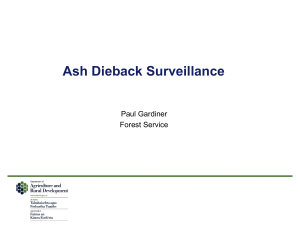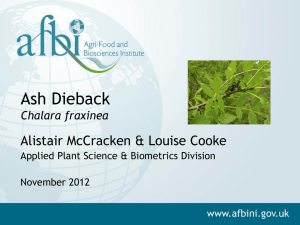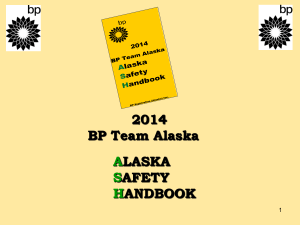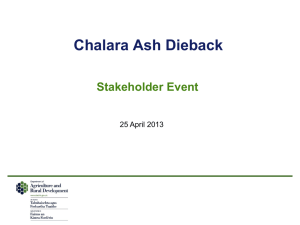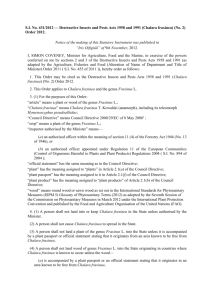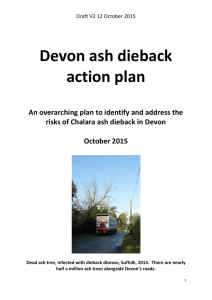Chalara Presentation (Microsoft PowerPoint, 6695 Kb)
advertisement
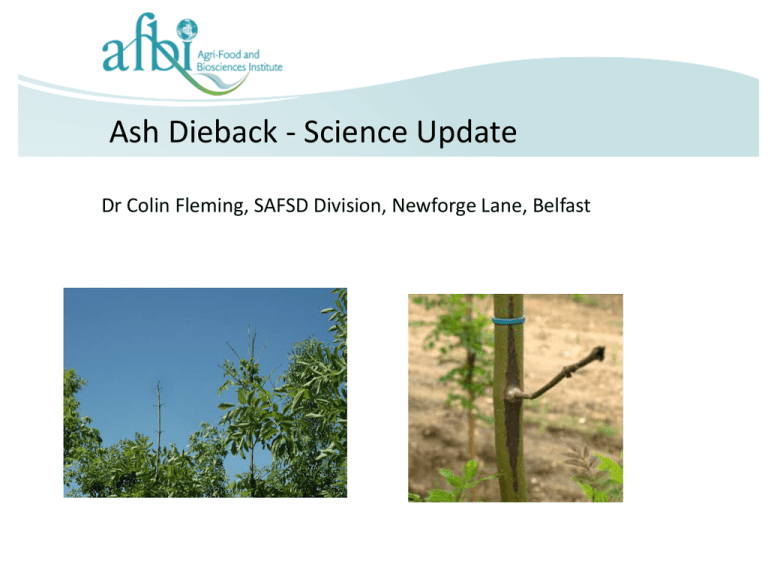
Ash Dieback - Science Update Dr Colin Fleming, SAFSD Division, Newforge Lane, Belfast ASH DIEBACK The fungus causing ash dieback (Chalara fraxinea) is an introduced pathogen Early 1990s: disease symptoms first observed in eastern Europe CHALARA FRAXINEA 2006: cause identified as a new fungal pathogen Chalara fraxinea (asexual stage) 2009: sexual stage identified, but thought to be a known species associated with leaf litter 2011: further study showed the species causing ash dieback is distinct - named Hymenoscyphus pseudoalbidus DISEASE Only attacks ash (Fraxinus spp.) Infects through leaves Grows into woody tissue causing distinctive lesions Sporulates in summer on leaf debris from previous year Spread by air-borne spores and movement of ash plants Asexual spermatia Sexually formed apothecia • Symptoms of Chalara fraxinae can be visible on leaves, shoots and branches of infected trees • In severe cases the entire crown shows leaf loss and dieback Detection and Diagnosis • Culturing Molecular 6- 24 hours Difficult to culture Very slow growing – could take 5 – 8 weeks to get a colony Hypothetical life cycle of Hymenoscyphus pseudoalbidus (from Gross et al., 2012, Fungal Genetics and Biology 49, 977–986) Infection and spread within the tree •Air-borne ascospores produced on infected, fallen leaves during the summer months (June-August in mainland Europe) infect healthy ash trees through the leaves Sexually formed apothecia •This results in the leaves withering and dying, and shoot lesions and stem lesions developing as the fungus grows into and through the leaf and into the woody tissue. •Leaf death results from the death of the leaf stalks (petioles and rachises) and tree death may result as the trunk and branches are killed by the fungus growing through them. •C. fraxinea grows through the woody tissue, killing it as it goes, into the heartwood of the tree. Young trees with slender stems may die quickly, but older trees may survive for several years, often succumbing to secondary organisms such as honey fungus. Sporulation and spread between trees •Infected leaves fall to the ground and decay, leaving the petioles. •The fungus forms blackened structures (pseudosclerotia) in the petioles. •Pseudosclerotia are melanised hyphae (strands of the fungus) which allow it to survive over the winter and in adverse conditions. •If two mating types of the fungus are present within the infected petioles, the fungus undergoes sexual reproduction and the following summer produces spore-bearing apothecia. •In adverse conditions (e.g. drought), the fungus can delay production of apothecia and survive for at least two years, producing apothecia in the subsequent summer. If an infected tree survives for more than a year and leafs out in subsequent seasons, the new leaves may not always be infective but .............. Infected tree producing newly infected leaves in the subsequent season Re-infection of new sprouts after cutting an infected tree Other factors •C. fraxinea has been detected in felled ash wood and can produce asexual conidia on this, but so far it has not proved possible either to germinate the conidia or to demonstrate them to be infective. •Therefore while it is prudent to consider the possibility that the disease might be spread by movement of infected logs, the risk appears to be low and can be minimised by appropriate treatment and trimming. •C. fraxinea has also been detected in ash seeds produced by trees affected by ash dieback. Seeds are clearly an infection risk. Management and Chemical control of Chalara •Removal of infected / potentially infected trees •Removal and destruction of ash leaf litter •Destruction of pseudosclerotia within ash petioles •Destruction of fruiting bodies and spores •Biosecurity at infected sites Times of year when symptoms are most likely to be observed Jan Leaf necrosis Shoot lesions Stem lesions Fruiting bodies Feb Mar Apr May Jun Jul Aug Sep Oct Nov Dec Resistance in Irish ash to the disease? BUM MUG ROE GAR NES BAN REA STR CLB CAI CLW INI HRK MAR REI ROS DRO CRA GLA WIB Genetic variation in Irish ash populations (PhD thesis Stephen Clarke, QUB) MAR4 STR12 MAR8 STR7 S Strabane Glen STR13 STR9 STR6 STR14 STR16 MAR6 MAR11 MAR13 MAR12 MAR14 MAR15 MAR18 MAR30 MAR9 MAR2 MAR3 MAR7 STR10 MAR16 MAR5 STR4 73 STR3 Roe Valley ROE21 STR17 MAR28 STR2 STR8 Roe Valley 63 MAR10 STR18 ROE12 ROE2 GAR7 Glenarriff NES7 CLW8 NES5 CLW3 CLW5 CLW4 71 MAR27 REA6 57 68 53 GAR11 GAR9 52 GAR19 BAN10 CLB12 BAN9 CLB5 CLB15 50 85 54 WIB8 51 Hanging Rock Rostrevor Banagher Glen B DRO6 DRO25 Clandeboye Figure 3.2. 3.1. Phylogenetic relationships between individual ash samples constructed by UPGMA from ISSR data. Bootstrap values in red. Groups from the Irish Republic in blue. Southeast in red, southwest brown, northeast green and northwest purple. Rea’s Wood Wise’s Bridge CLB 17 CLB16 HRK13 GAR18 GAR24 BAN5 CLB13 CLB9 BAN4CLB14 CLB4 GLA7 57 BAN7 CLB7 HRK2HRK3 BAN6 BAN3 CLB11 HRK4 GLA5 BAN1 HRK7 HRK5 GLA6 CLB1 CLB18 HRK14 DRO22 GLA9 CLB10 HRK8 GLA4 HRK1 72 CLB2 GLA3 DRO23 52 HRK12 HRK17 GLA8 GLA2 DRO18 HRK16 HRK18 HRK11 DRO17 DRO26 HRK9 HRK6 HRK20 HRK19 DRO20 DRO19 GAR25 CLW6 REA4 REA9 REA2 REA7 REA8 REA3 REA13 REA10 REA18 REA17 REA12 WIB1ROS2 REA14 ROS1ROS9 ROS4 ROS8 REA11 ROS6 ROS7 BAN16WIB9 ROS5 REA15 WIB2 WIB6 REA16 HRK10 WIB4 WIB7 BAN14 BAN20REI7 WIB3WIB5 ROE23 BAN21 REI10 BAN18 REI6 BAN13 BAN12 MAR1 BAN11 CLB3 65 ROE27REI9 NES4 ROE26 56 DRO21 ROE28 ROE24REI1 BAN19 ROE25 REI5 NES8 BAN15 DRO4 BAN17 NES9 DRO1 CLB6 GLA1 DRO3 DRO2 DRO7DRO5 74 DRO8 65 69 GAR17 GAR28 GAR16 GAR27 GAR29 GAR1 58 GAR4 GAR3 GAR6 GAR20 GAR23 GAR5GAR2 GAR26 GAR22 GAR21 Clare Wood CLW2 55 CLW7 REA1 REA5 GAR13 GAR8 MAR33 MAR36 NES1 MAR35 NES6 NES3 CLW10 ROE4 ROE5 MAR32 STR15 67 GAR15 MAR31 CLW1 MAR25 MAR29 MUG6 ROE7 ROE1 Marble Arch CLW9 MUG3 ROE16 ROE15 MUG2 ROE14 MUG4 ROE22 ROE17 65 ROE13 MUG1 ROE18 ROE11 ROE6 ROE10 MUG5 ROE3 ROE8 MAR24 MAR21 MAR20 MAR19 MAR34 MAR22 MAR26 MAR23 STR11 ROE20 Muff Glen MAR17 STR5 STR1 93% genetic variation within populations DRO16 DRO12 DRO13 DRO15 DRO14 Glashaboy River Dromore Wood Genetic variation in Chalara? European studies on Chalara show: •2 mating types •Founder effect •High gene flow •Low geographic variation Questions for NI outbreaks: 2 mating types? Genetic diversity?

